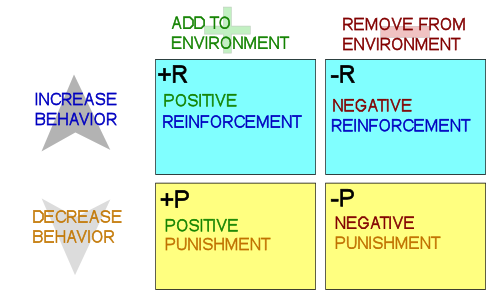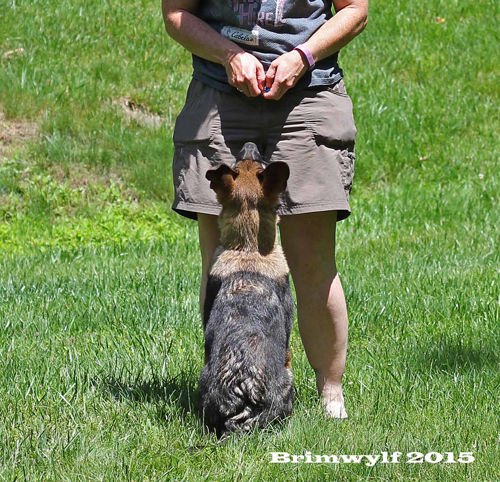Training Theory
It is possible to train dogs without knowing any learning theory, but it can also help to clarify some of the process of training. There are several key concepts and definitions that are helpful to know.
Classical Conditioning
Classical conditioning is the association of a neutral stimulus with an unconditioned stimulus. The famous experiment by Pavlov explains this phenomena. By ringing a bell (neutral stimulus) just prior to feeding a dog, the dog began salivating (unconditioned stimulus) as soon as the bell was rung. Salivating is a natural response to the presence of food. It does not need to be taught. Classical conditioning happens constantly during training, associations are made between antecedants and behaviors. This doesn't just happen with food and salivation, but also with trained behaviors, such as associations between a word or body language of the trainer and a behavior that follows. The dog begins to anticipate the following behavior.
Operant Conditioning
Operant conditioning is a name often wrongly applied to clicker training. In fact many clicker trainers generally use just one or two of the quadrants of Operant Conditioning. In behavioral terms "positive" means something is added to the situation, "negative" means something is taken away, it does not mean "good" or "bad". "Reinforcement" means that the behavior is more likely to be repeated after it is applied, "punishment" means the behavior is less likely to be repeated afterwards.
"Punishment" is often thought of as a physical correction when dog training, but remember that it is the dog that defines what is punishing and this will be different for each dog. "Reinforcement" is usually thought of as rewarding the dog with food or a toy, but something is only reinforcing to a dog if it means he performs that behavior more often. Many people apply their own ideas and emotions to define what is punishing or reinforcing without looking to see if the dog is performing the behavior more or less often.
Positive Reinforcement The dog receives something that he finds rewarding (play, food, toy) for performing a behavior. This makes him MORE likely to perform the behavior again.
Positive Punishment The dog receives something that he finds aversive/uncomfortable (correction, water spray) for performing a behavior. This makes him LESS likely to perform the behavior again.
Negative Reinforcement The dog is put in a position he finds uncomfortable (tight leash, ear pinch, electric stim) until he performs a behavior. This makes him MORE likely to perform the behavior again.
Negative Punishment The dog has access to something he finds rewarding, he performs a behavior his owner doesn't want and the reward is taken away. This makes him LESS likely to perform the behavior again.

there are several other definitions that are used in conjunction with operant training.
Stimulus An event that affects one or more of the animal's senses, sight, sound, touch, smell or taste.
Contingent Something that happens depending on a prior action.
Primary Reinforcer This is reinforcement which is not taught, such as food, social interaction, physical comfort etc.
Secondary Reinforcer This is reinforcement which becomes reinforcing as a result of being paired with a primary reinforcer. This includes clickers, the word "good", the word "no" etc.
Innate / Instinctive Behaviors
All animals perform behaviors that they do not have to be taught. Many natural behaviors have developed over thousands of years and have helped different species to be successful. Sometimes it can be hard to see the "reinforcing" element of the behavior, for example, the well-fed cat that catches and kills mice but does not eat them. Some of these behaviors are considered self-reinforcing and many are unconditioned. They do not fit well with the operant training model, many trainers talk about the fact that handlers or their rewards must be more "exciting" than the environment around the dog to prevent the dog from disengaging and indulging in instinctive behaviors such as sniffing or chasing squirrels. It is possible to design training and have enough reinforcement history to make the innate behaviors less enticing, but they never leave the behavioral repertoire altogether.
Luring, Molding, Shaping and Targeting
Luring As a first time handler, it is generally easier to start with luring and other reward based training methods, where you use a favorite toy or food to help your dog into the position you are looking for (for example, if you hold a piece of food by a pups nose, and raise your hand slowly above the pups head, he should sit). The caveat to this, is that the dog will be thinking about the food, toy, or body language used for the lure and not what he is doing to learn the command.
The most important thing to remember about luring, is that the lure must be faded. When the dog is performing the exercise consistently, a voice command can be added. Then the food can be removed from the hand but still use the same hand or body language, then gradually make the hand signal less and less.
Advantages of luring include being able to train many behaviors at once, it is also typically a very quick method of training.
Molding is where you use your hands, leash or other physical guide to help the dog to perform the action or get in to position. This method is also easy for beginners, it is technically compulsion, but it can be done by gently stroking or blocking the dog from going forward which many people might not consider compulsion. Another example is using a wall to keep the dog's body straight while heeling, or the use of guides or platforms to position the dog.
It is often difficult to use exactly the same amount of pressure each time when molding, and if the pressure gets too much, the dog may resist due to the opposition reflex.
Shaping is where you use a clicker or other audible marker to mark a behavior your dog may perform naturally like a sit or a down, and once the dog is offering that behavior consistently, you can add the command (this is often referred to as free-shaping). A step further than this, you can try shaping a more complex behavior bit by bit with a clicker. In order to shape a complicated behavior, you have to be able to break down the behavior you are looking for into very small pieces and gradually approximate towards the actions you are looking for. The power of this shaping is that the dog "learns to learn" and to think about what they are doing.
Shaping can be quite frustrating in the beginning, but it is the best way to learn how the timing of the reward affects the dog's behavior. Timing of reward (and correction) is an important training skill to master no matter what training tools you use. Starting with a clicker allows you to experiment, and any mistakes should not, ultimately, affect the relationship between you and your dog or your dogs general confidence. This is important for Schutzhund; young dogs should not be subjected to corrections such as prong collar corrections until they are confident enough to take them. Otherwise, you may find that, for all of your training, you fail to achieve the results you desire because your dog does not show the desired attitude in his work.
Shaping is an excellent way to break down complex behaviors such as the retrieve. Planning the breakdown and setting goals for each step helps handlers to analyse the behaviors required during training. To be successful, it requires exquisite timing, so it tends to be a slower method for beginners.
Targeting We can teach the dog to go to a target and touch it, either with paw or nose or perform another position when he reaches the target, by luring, molding or shaping methods. Then, we can use the target as part of another more complicated lesson, such as going over a jump to a target and then back. Targeting can also be used in heeling with the hand touch to get the nose in the desired position.
Combining methods These techniques can be combined to get faster results. For instance, if you are shaping your dog to go to a box or dumbell, you can reward him by throwing the food on the box or next to the dumbell. This lures the dog back to the object so he is more likely to be successful at the next repetition. Conversely, we can also throw the reward away from the item so that part of the behavior includes moving towards the object.

Recommended Video:
Recommended Reading:
These links are adverts for products for sale on Amazon.com.
As an Amazon Associate I earn from qualifying purchases.
These earnings help pay
for hosting for this website.